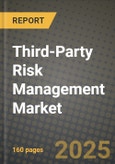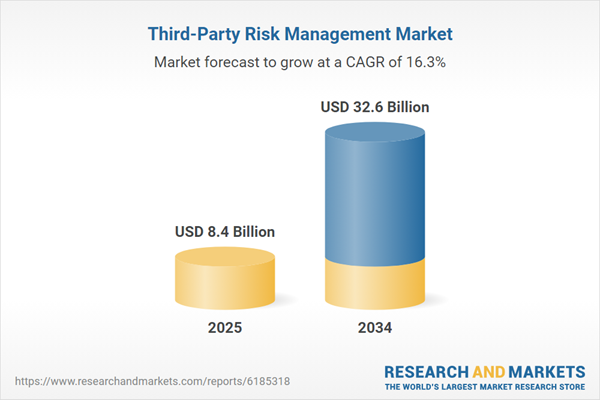The Third-party Risk Management (TPRM) Market has become a critical pillar of enterprise governance, risk, and compliance (GRC) frameworks, especially as organizations increasingly outsource operations and partner with external vendors. TPRM solutions help businesses assess, monitor, and mitigate the risks associated with their third-party relationships - including cybersecurity threats, data privacy breaches, regulatory non-compliance, and operational disruptions. As global supply chains, IT ecosystems, and financial networks grow more interconnected, managing these third-party exposures has evolved from a compliance necessity to a strategic imperative. Industries such as banking, healthcare, energy, and technology are particularly dependent on TPRM to safeguard reputation, protect sensitive data, and maintain regulatory alignment. This market encompasses software platforms, managed services, and consulting support aimed at streamlining vendor onboarding, automating risk assessments, and enhancing visibility across extended enterprise networks.
The TPRM market experienced accelerated growth due to a wave of cybersecurity incidents, increasing regulatory scrutiny, and heightened board-level attention to enterprise risk. Several high-profile data breaches and supply chain attacks underscored the need for proactive third-party risk oversight, particularly in sectors dealing with critical infrastructure and personal data. Organizations intensified their use of TPRM platforms to automate due diligence, track risk scores, and monitor real-time vendor threats. Artificial intelligence (AI) and machine learning (ML) algorithms became more embedded in TPRM tools, enabling faster risk scoring, anomaly detection, and predictive analytics. Regulatory bodies globally - such as the SEC, EBA, and MAS - issued stricter guidelines around third-party governance, pushing companies to expand their audit trails and documentation processes. Additionally, environmental and social risk assessment gained traction, prompting businesses to evaluate suppliers not only for security and compliance but also for ESG alignment and ethical sourcing practices.
The third-party risk management market is expected to integrate deeper with enterprise-wide GRC, procurement, and cybersecurity programs. Future developments will include decentralized risk registries using blockchain, continuous monitoring with AI-enabled threat intelligence, and expanded coverage for fourth- and fifth-party risks. As organizations build resilience against geopolitical shocks, supply chain instability, and ESG-related disruptions, TPRM platforms will serve as central command hubs for multi-dimensional risk oversight. The emergence of industry-specific TPRM templates and collaborative risk exchange networks will help streamline vendor assessments across sectors such as financial services, pharmaceuticals, and defense. However, managing data quality, standardizing risk metrics across global operations, and overcoming internal silos will remain major obstacles, particularly for large enterprises operating with fragmented systems and legacy processes.
Key Insights: Third-Party Risk Management Market
- Integration of ESG criteria into third-party risk assessments is gaining momentum, as organizations seek to ensure ethical sourcing, sustainability, and social compliance across vendor networks.
- Real-time risk monitoring powered by AI and external threat intelligence feeds is enabling dynamic updates to vendor risk profiles and response prioritization.
- Collaboration platforms for shared risk intelligence among peers and industry groups are emerging, helping to reduce duplication and improve transparency in vendor vetting.
- Increased use of natural language processing (NLP) to analyze contracts and policies for hidden risks and non-compliant clauses is streamlining due diligence processes.
- TPRM platforms are becoming more modular and API-driven, facilitating seamless integration with ERP, procurement, and cybersecurity ecosystems.
- Rising cybersecurity threats and ransomware attacks through third-party vendors are pushing enterprises to invest in continuous and automated vendor risk assessment tools.
- Expanding regulatory requirements across global jurisdictions are requiring more structured and documented third-party oversight to avoid compliance penalties.
- Digital transformation and outsourcing of critical operations are increasing the exposure surface, necessitating scalable and centralized third-party risk frameworks.
- Demand for operational resilience and supply chain continuity is growing in the face of global disruptions, driving demand for vendor risk mapping and contingency planning.
- The key challenge in the TPRM market lies in ensuring consistent and high-quality data inputs for risk scoring across large, diverse supplier bases - especially when onboarding vendors in different regions, regulatory environments, and technology maturity levels, which hampers accuracy, scalability, and stakeholder trust in the system.
Third-Party Risk Management Market Segmentation
By Component
- Solution
- Services
By Deployment Type
- Cloud Based
- On-Premises
By Organization Size
- Small and Medium Size Enterprises
- Large Enterprises
By End User
- Banking
- Financial Services
- and Insurance
- IT and Telecom
- Healthcare and Life Sciences
- Government
- Aerospace and Defense
- Retail and Consumer Goods
- Manufacturing
- Energy and Power
- Other End Users
Key Companies Analysed
- RSA Security LLC (Archer Suite)
- MetricStream, Inc.
- ProcessUnity, Inc.
- Prevalent, Inc.
- BitSight Technologies
- OneTrust, LLC
- LogicGate, Inc.
- SAI360
- Refinitiv (London Stock Exchange Group)
- RiskRecon (Mastercard)
Third-Party Risk Management Market Analytics
The report employs rigorous tools, including Porter’s Five Forces, value chain mapping, and scenario-based modeling, to assess supply-demand dynamics. Cross-sector influences from parent, derived, and substitute markets are evaluated to identify risks and opportunities. Trade and pricing analytics provide an up-to-date view of international flows, including leading exporters, importers, and regional price trends.Macroeconomic indicators, policy frameworks such as carbon pricing and energy security strategies, and evolving consumer behavior are considered in forecasting scenarios. Recent deal flows, partnerships, and technology innovations are incorporated to assess their impact on future market performance.
Third-Party Risk Management Market Competitive Intelligence
The competitive landscape is mapped through proprietary frameworks, profiling leading companies with details on business models, product portfolios, financial performance, and strategic initiatives. Key developments such as mergers & acquisitions, technology collaborations, investment inflows, and regional expansions are analyzed for their competitive impact. The report also identifies emerging players and innovative startups contributing to market disruption.Regional insights highlight the most promising investment destinations, regulatory landscapes, and evolving partnerships across energy and industrial corridors.
Countries Covered
- North America - Third-Party Risk Management market data and outlook to 2034
- United States
- Canada
- Mexico
- Europe - Third-Party Risk Management market data and outlook to 2034
- Germany
- United Kingdom
- France
- Italy
- Spain
- BeNeLux
- Russia
- Sweden
- Asia-Pacific - Third-Party Risk Management market data and outlook to 2034
- China
- Japan
- India
- South Korea
- Australia
- Indonesia
- Malaysia
- Vietnam
- Middle East and Africa - Third-Party Risk Management market data and outlook to 2034
- Saudi Arabia
- South Africa
- Iran
- UAE
- Egypt
- South and Central America - Third-Party Risk Management market data and outlook to 2034
- Brazil
- Argentina
- Chile
- Peru
Research Methodology
This study combines primary inputs from industry experts across the Third-Party Risk Management value chain with secondary data from associations, government publications, trade databases, and company disclosures. Proprietary modeling techniques, including data triangulation, statistical correlation, and scenario planning, are applied to deliver reliable market sizing and forecasting.Key Questions Addressed
- What is the current and forecast market size of the Third-Party Risk Management industry at global, regional, and country levels?
- Which types, applications, and technologies present the highest growth potential?
- How are supply chains adapting to geopolitical and economic shocks?
- What role do policy frameworks, trade flows, and sustainability targets play in shaping demand?
- Who are the leading players, and how are their strategies evolving in the face of global uncertainty?
- Which regional “hotspots” and customer segments will outpace the market, and what go-to-market and partnership models best support entry and expansion?
- Where are the most investable opportunities - across technology roadmaps, sustainability-linked innovation, and M&A - and what is the best segment to invest over the next 3-5 years?
Your Key Takeaways from the Third-Party Risk Management Market Report
- Global Third-Party Risk Management market size and growth projections (CAGR), 2024-2034
- Impact of Russia-Ukraine, Israel-Palestine, and Hamas conflicts on Third-Party Risk Management trade, costs, and supply chains
- Third-Party Risk Management market size, share, and outlook across 5 regions and 27 countries, 2023-2034
- Third-Party Risk Management market size, CAGR, and market share of key products, applications, and end-user verticals, 2023-2034
- Short- and long-term Third-Party Risk Management market trends, drivers, restraints, and opportunities
- Porter’s Five Forces analysis, technological developments, and Third-Party Risk Management supply chain analysis
- Third-Party Risk Management trade analysis, Third-Party Risk Management market price analysis, and Third-Party Risk Management supply/demand dynamics
- Profiles of 5 leading companies - overview, key strategies, financials, and products
- Latest Third-Party Risk Management market news and developments
Additional Support
With the purchase of this report, you will receive:- An updated PDF report and an MS Excel data workbook containing all market tables and figures for easy analysis.
- 7-day post-sale analyst support for clarifications and in-scope supplementary data, ensuring the deliverable aligns precisely with your requirements.
- Complimentary report update to incorporate the latest available data and the impact of recent market developments.
This product will be delivered within 1-3 business days.
Table of Contents
Companies Mentioned
- RSA Security LLC (Archer Suite)
- MetricStream Inc.
- ProcessUnity Inc.
- Prevalent Inc.
- BitSight Technologies
- OneTrust LLC
- LogicGate Inc.
- SAI360
- Refinitiv (London Stock Exchange Group)
- RiskRecon (Mastercard)
Table Information
| Report Attribute | Details |
|---|---|
| No. of Pages | 160 |
| Published | October 2025 |
| Forecast Period | 2025 - 2034 |
| Estimated Market Value ( USD | $ 8.4 Billion |
| Forecasted Market Value ( USD | $ 32.6 Billion |
| Compound Annual Growth Rate | 16.2% |
| Regions Covered | Global |
| No. of Companies Mentioned | 10 |









